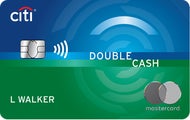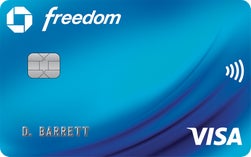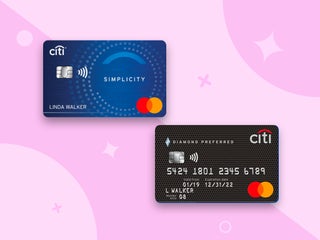Summary
The Citi Double Cash and Chase Freedom cards both offer generous cash back on everyday purchases, like gas and groceries. But instead of choosing between the two, you may be better off with both. Read on to see why.
The content on this page is accurate as of the posting date; however, some of our partner offers may have expired. Please review our list of best credit cards, or use our CardMatch™ tool to find cards matched to your needs.
If you’re looking for a reliable rewards card to use for everyday purchases, the Citi Double Cash Card and the Chase Freedom are both good cards to have in your wallet. Each card offers a substantial amount of cash back on the purchases you’re likely to make the most, such as groceries and gas, and neither card charges an annual fee – unlike some rewards cards with similar perks.
The Citi Double Cash card and the Chase Freedom card are very different products, though, so you’ll want to think carefully about your spending habits and rewards preferences before you pick one. Choosing between the two comes down to how much maintenance you want to put into maximizing your card’s rewards value and how you plan to use your earnings.
Taking a closer look
The Citi Double Cash card offers up to 2 percent cash back on every purchase (1 percent when you buy and 1 percent as you pay), making it ideal for busy cardholders who don’t have time to deal with a high maintenance rewards card. If you don’t plan to put a lot of work into your rewards earning strategy, this card offers more than enough value to use every day.
The Chase Freedom card isn’t nearly as flexible as the Citi Double Cash card and requires some maintenance. But if you’re a savvy rewards user who doesn’t mind taking the time to track your spending and occasionally shift your purchases, you could earn substantially more using the Freedom card. The card offers 5 percent cash back on a rotating list of quarterly bonus categories, such as restaurants, groceries and department stores, and 1 percent cash back on everything else.
The Chase Freedom card and the Citi Double Cash card also work exceptionally well as a pair. So if you don’t mind carrying a handful of cards in your wallet, you may want to consider getting both. Here’s what else we found when comparing the two cards:
Citi Double Cash versus Chase Freedom
 Citi Double Cash card |  Chase Freedom card | |
| Rewards rate | Up to 2% cash back:
|
|
| Sign-up bonus | None |
|
| Annual fee | $0 | $0 |
| Estimated yearly rewards value (for someone who spends $15,900) | $318 | $239 |
| Pros |
|
|
| Cons |
|
|
| Who should get this card? |
|
|
Best for someone who wants a low maintenance rewards card: Citi Double Cash card
If you want to earn a large amount of cash back, but don’t want to track your spending or regularly opt into quarterly bonus categories, the Citi Double Cash card is hard to beat. A true hands-off credit card, the Citi Double Cash pays 1 percent cash back when you make a purchase and another 1 percent back when you pay your bill on time. That means you can earn 2 percent cash back on everything from everyday bills to dry cleaner charges and grocery store runs.
The Chase Freedom card, by contrast, requires you to opt into a new bonus category every quarter and keep track of which categories are earning the bonus. If you forget to opt in each quarter – which is easy to do, despite Chase’s email reminders – you’ll only earn 1 percent cash back. You also need to take some time to strategize your quarterly spending plan if you want to maximize this card’s rewards potential.
Best for someone who wants to earn a sign-up bonus: Chase Freedom card
The Chase Freedom card offers an easy way to earn a quick influx of cash: You’ll receive a $150 sign-up bonus when you spend $500 in the first three months of card membership. That could make the Freedom card slightly more valuable than the Citi card in the first year.
The Citi Double Cash card, by contrast, doesn’t offer a sign-up bonus, so you’ll have to wait a while before you earn that amount back in rewards. You won’t automatically get 2 percent cash back with the Citi Double Cash card either, so you’ll also have to be more patient with your earnings. Instead, Citi awards 1 percent back when you make a purchase and then gives you another 1 percent back when you’ve paid for your purchase.
Best for someone who wants to maximize rewards earnings without shifting their spending habits: Citi Double Cash card
The Freedom card offers a flashy 5 percent bonus, but its earning limitations make the card less valuable than it appears. For example, Chase caps the 5 percent bonus at $1,500 per quarter and limits the amount of time you can take advantage of a bonus category to three months. As a result, you will likely earn more overall with the Citi Double Cash card if you’re a casual card user who doesn’t take the time to shift spending based on the bonus categories.
Consider, for example, how much you’ll earn in one year with each card if you spend roughly $200 a month on gas. With the Chase Freedom card, you were able to earn 5 percent cash back on gas during the first quarter of 2018 – equaling out to $30 back at the end of the bonus period. For the remainder of the year, you’ll earn 1 percent cash back on gas – for an additional $18.
If you stick with the Citi Double Cash card all year and charge $200 a month, you’ll earn the exact same amount: $48 in gas earnings by the end of the year.
Cash back on $200 monthly gas spend
| Citi Double Cash card | Chase Freedom card |
| $200 x 2% cash back x 12 months = $48 | ($200 x 5% cash back x 3 months) + ($200 x 1% cash back x 9 months) = $48 |
The same is true if you max out your grocery spending and charge $1,500 on the Chase Freedom card during the three-month period that it offers 5 percent cash back on groceries. If you regularly spend $500 a month on groceries, you’ll earn $120 by the end of the year.
If you use the Citi Double Cash card to charge $500 per month on groceries, you’ll earn the exact same amount at the end of the year.
Cash back on $500 monthly grocery spend
| Citi Double Cash card | Chase Freedom card |
| $500 x 2% cash back x 12 months = $120 | ($500 x 5% cash back x 3 months) + ($500 x 1% cash back x 9 months) = $120 |
What sets the Citi Double Cash card apart from the Chase card, though, is that it gives an additional 2 percent cash back on other purchases, such as your dry cleaning and doctor’s appointments. So you’ll earn significantly more overall with the Citi Double Cash card. We estimate that the average Citi Double Cash cardholder earns around $318 when they spend $15,900 a year. The average Freedom cardholder earns $243.
Best for rewards maximizers: Chase Freedom card
You may be able to squeeze out significantly more earnings with the Freedom card if you strategize your rewards spending and max out your earnings every time you’re awarded a new quarterly bonus.
For instance, if you typically spend $125 a month on restaurant purchases, you’ll get $30 back by the end of the year with the Citi Double Cash card. With the Chase Freedom card, you’ll earn 5 percent back during the 3 months that restaurants earn a bonus, and 1 percent back during the remaining 9 months – which also gives you $30.
But if you max out the Freedom card’s $1,500 cap on bonus spending by also purchasing restaurant gift cards during that quarter, you’ll earn $75 cash back in that quarter alone. You can then use those gift cards to dine out for the remainder of the year.
Cash back on $125 monthly restaurant spend ($1,500 per year)
| Citi Double Cash card | Chase Freedom card |
| $125 x 2% cash back x 12 months = $30 | ($125 x 5% cash back x 3 months) + ($1,125 restaurant gift cards x 5% cash back) = $75 |
You can pursue a similar strategy with the card’s quarterly retail bonus. Every year, Freedom awards 5 percent back to a retail store, such as Walmart, or to a wholesale store, such as Sam’s or Costco. If you typically spend at least $1,500 a year at those stores, you could buy $1,500 worth of gift cards during the 5 percent bonus period and earn another $75 in rewards.
Cash back on $125 monthly department store spend ($1,500 per year)
| Citi Double Cash card | Chase Freedom card |
| $125 x 2% cash back x 12 months = $30 | ($125 x 5% cash back x 3 months) + ($1,125 department store gift cards x 5% cash back) = $75 |
Best card for frequent travelers: Chase Freedom card
The Freedom card boasts an additional, less obvious way to maximize your rewards earnings and potentially earn more than the Double Cash card: If you own a Chase travel card, such as the Chase Sapphire Preferred card or the Sapphire Reserve, you can convert your cash into miles and earn a 25 to 50 percent bonus on travel redeemed through Chase Ultimate Rewards.
That could boost your rewards earnings significantly if you transfer a large amount. For example, imagine you earned $300 a year (30,000 points) from the Chase card just by maximizing the card’s quarterly bonus program. If you transferred that cash to the Chase Sapphire Reserve card and redeemed your miles for travel through Chase Ultimate Rewards, you’d earn a 50 percent bonus and have at least $450 to spend on a free flight. If you transferred it to the Chase Sapphire Preferred card and redeemed it for travel, you’d earn a 25 percent bonus and have at least $375 to spend.
Chase Ultimate Rewards redemption options
| Redemption option | Point value | Value of 30,000 points |
| Sapphire Reserve travel redemption (50% bonus) | 1.5 cents | $450 |
| Sapphire Preferred travel redemption (25% bonus) | 1.25 cents | $375 |
| Statement credit | 1 cent | $300 |
| Direct deposit | 1 cent | $300 |
| Gift cards | 1 cent | $300 |
| Amazon.com purchases | 0.8 cent | $240 |
| Chase Pay purchases | 0.8 cent | $240 |
Chase also lets you transfer your miles on a one-to-one basis to other airlines and hotels, such as United Airlines, Southwest Airlines, Virgin Atlantic, British Airways, Air France, Korean Air, Singapore Airlines, Hyatt, Ritz Carlton, Marriott and IHG.
You can get even better values with your rewards points on some of these partners – making those 30,000 transferred points worth $500 or more, depending on the airline partner and the flight.
Chase Ultimate Rewards transfer partners (qualified cards only)
| Transfer option | Average point value | Value of 30,000 points |
| British Airways transfer | 2.29 cents | $687 |
| Singapore Airlines transfer | 2.17 cents | $651 |
| Southwest Airlines transfer | 1.57 cents | $471 |
| United Airlines transfer | 1.52 | $456 |
| Korean Air transfer | 1.4 cents | $420 |
| Hyatt Gold Passport transfer | 1.37 cents | $411 |
| Ritz-Carlton transfer | 1.22 cents | $366 |
| Virgin Atlantic transfer | 0.8 cent | $240 |
| Marriott Rewards transfer | 0.8 cent | $240 |
| IHG transfer | 0.65 cent | $195 |
An even better way to maximize your earnings: Get both
If you want to earn as much cash back as possible without paying an annual fee, consider applying for both credit cards and pairing them. If you use the Chase Freedom card each time it earns a 5 percent bonus and use the Citi Double Cash card for all other purchases, you can potentially earn a large amount by the end of the year.
For example, if you use the Chase Freedom card to purchase groceries during the three months it earns a 5 percent bonus and use the Citi Double Cash card on groceries the rest of the year, you’ll earn $45 more than if you just use the Freedom card.
Cash back on $500 monthly grocery spend
| Citi Double Cash card + Chase Freedom card | Chase Freedom card |
| ($500 x 5% cash back x 3 months) + ($500 x 2% cash back x 9 months) = $165 | ($500 x 5% cash back x 3 months) + ($500 x 1% cash back x 9 months) = $120 |
Similarly, you’ll earn a substantial amount back on restaurants. For example, if you regularly spend $150 a month on restaurant spending and use the Freedom card during the 5 percent bonus period and the Citi Double Cash card for the rest of the year, you’ll earn nearly $50 in cash back.
Cash back on $150 monthly restaurant spend
| Citi Double Cash card + Chase Freedom card | Chase Freedom card |
| ($150 x 5% cash back x 3 months) + ($150 x 2% cash back x 9 months) = $49.50 | ($150 x 5% cash back x 3 months) + ($150 x 1% cash back x 9 months) = $36 |
Which is best for you?
The Chase Freedom card and the Citi Double Cash card are both great cards to use for everyday errands. But if you just want one low maintenance card and aren’t willing to put work into maximizing your rewards, you’ll get more value out of the Citi Double Cash card.
That said, if you don’t mind keeping a few cards in your wallet, you’ll get even more out of your everyday spending if you pick up both cards and alternate them, depending on which card earns the largest reward.
See related: Chase unveils its cash back category for Q1 2018
The editorial content below is based solely on the objective assessment of our writers and is not driven by advertising dollars. However, we do receive compensation when you click on links to products from our partners. Learn more about our advertising policy
Editorial Disclaimer
The editorial content on this page is based solely on the objective assessment of our writers and is not driven by advertising dollars. It has not been provided or commissioned by the credit card issuers. However, we may receive compensation when you click on links to products from our partners.



